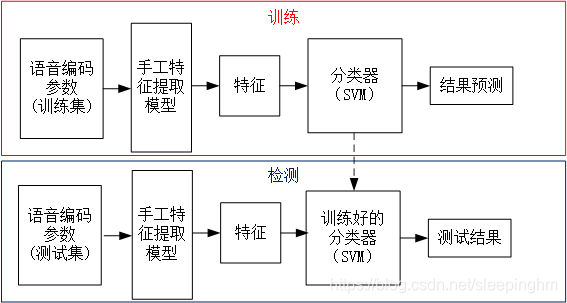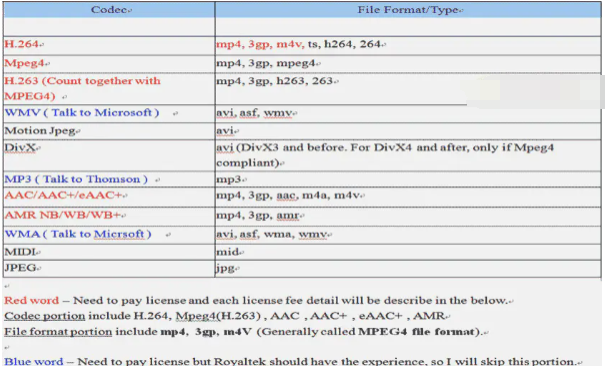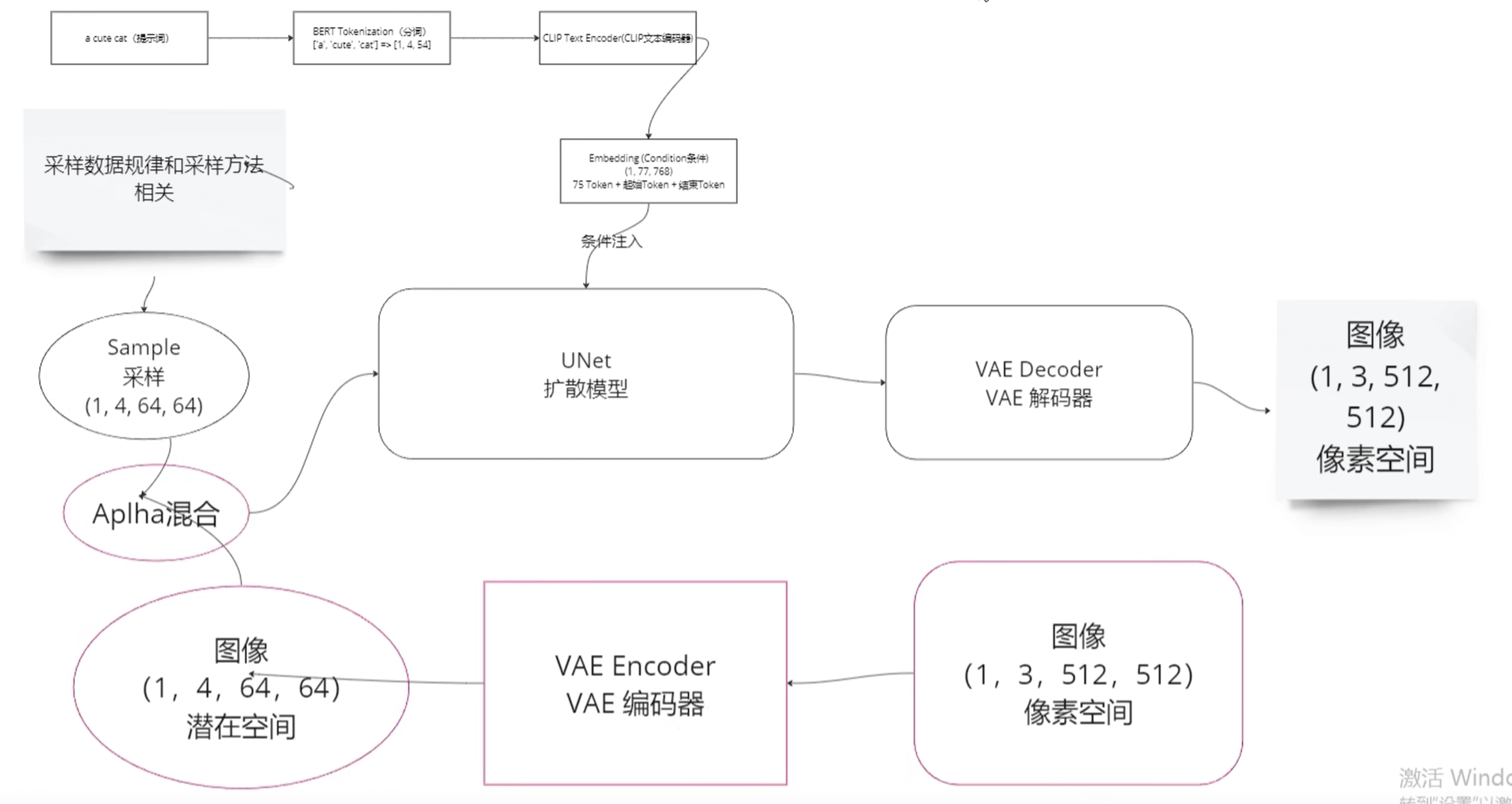欢迎访问我的个人博客:https://hi.junono.com/
AMR隐写数据集地址(Kaggle)
网络语音流隐写分析全流程
- 隐写分析流程介绍:
- 基本知识
- **基于网络语音(VoIP)流的隐写术及隐写分析**
- 1. 数据集准备(语音编码参数)
- 1.1 使用现成的语音编码参数
- 1.2 自己准备编码参数
- 1.2.1 wav->pcm
- 1.2.2 pcm->dat
- 1.2.3 dat->txt
- 2. 隐写分析
- 2.1 RSM
- 3. AMR隐写分析数据集—Kaggle
- Reference:
隐写分析流程介绍:
基于“手工特征+分类器”的隐写分析方法:

基于深度学习的隐写分析方法:深度学习模型自动提取特征,经过分类层给出分类结果。

基本知识
隐写(Steganography):在不影响载体质量的情况下将秘密信息隐藏在多媒体载体(图像,音频,视频等)中并通过公共信道进行安全传播,除了发送方和接收方,第三者无法察觉秘密信息的存在。
隐写分析(Steganalysis):检测这段多媒体中是否有秘密信息的存在,为二分类任务。
影响隐写分析检测性能的两个重要指标:嵌入率和样本长度。
- 嵌入率(Embedding Rate): E M R = 秘 密 信 息 比 特 数 载 体 比 特 数 EMR=\frac{秘密信息比特数}{载体比特数} EMR=载体比特数秘密信息比特数,有100%到0%不等。其中0%嵌入率为载体样本(cover),0以上为载密样本(stego)。
- 样本长度(Sample Length): 语音样本时长,有10秒,1秒不等。
评价指标(Evaluation Metrics):精度ACC;虚警率FPR;漏检率FNR;检测时长。
一般而言,检测精度越高,虚警率漏检率越低,检测速度越快越好。
- A C C = N T P + N T N N T P + N T N + N F P + N F N ACC = \frac{N_{TP}+N_{TN}}{N_{TP}+N_{TN}+N_{FP}+N_{FN}} ACC=NTP+NTN+NFP+NFNNTP+NTN,指的是正确分类的样本占所有样本的比率,若ACC越高,检测性能就越好。其中, N T P N_{T P} NTP为正确分类为阳性(隐写)样本的数量; N T N N_{TN} NTN为正确分类为阴性(未隐写)样本的数量, N F P N_{FP} NFP为将阴性(未隐写)样本错误分类为阳性(隐写)样本的数量; N F N N_{FN} NFN为将阳性(隐写)样本错误分类为阴性(未隐写)样本的数量。
- F P R = N F P N T N + N F P FPR = \frac{N_{FP}}{N_{TN}+{N_{FP}}} FPR=NTN+NFPNFP,指的是在所有实际为阴性的样本中,被错误地判断为阳性的比率,能够反映误检的情况。
- F N R = N F N N T P + N F N FNR= \frac{N_{FN}} {N_{TP} + {N_{FN}}} FNR=NTP+NFNNFN,指的是在所有实际为阳性的样本中,被错误地判断为阴性之比率,能够反映漏检的情况。
- 检测时长: 平 均 测 试 时 间 = T t e s t T s a m p l e l e n g t h 平均测试时间=\frac{T_{test}}{T_{sample length}} 平均测试时间=TsamplelengthTtest (average testing time over sample length)。要给出具体的电脑配置。
基于网络语音(VoIP)流的隐写术及隐写分析
VoIP 编码为压缩编码, 在编码后语音文件会变成相应参数, 而参数编码过程中的隐写方法又可以根据隐写方式分为最低有效位(least significant bit, LSB)隐写和量化索引调制(quantized index modulation,QIM)隐写。
- LSB 隐写:基于 VoIP 编码器编码过程中的冗余提出的隐写方案。在编码中检测某些参数属于最低有效位, 并修改为秘密信息。
- QIM 隐写:利用 VoIP 编码器的码本编码特性划分码本来隐藏信息的方法,即动态选择最佳激励向量的量化索引值,同时尽可能地最小化合成语音的失真,以实现信息隐藏。
VoIP 的编码器大多使用码本激励线性预测编码 ( code excited linear prediction,CELP)编码规则编码。编码器根据实现分为:线性预测分析、基音搜索和固定码本搜索。
因此编码过程中最重要的参数为:线性预测(linear predictivecoefficients,LPC) 参数, 固定码本(fixed codebook,FCB)参数,自适应码本(adaptive codebook,ACB)参数和Gain 参数。其中Gain参数冗余太小不适于隐写, 在参数隐写的部分基本上是前面 3 种或者混合。
LPC,FCB,ACB 参数编码都是使用码本的参数编码, 所以既可以使用LSB 方式隐写又可以根据QIM方式隐写, 对于隐写, 提出的隐写方案更加侧重于隐写方法, 其目的在于如何使提出的方法能够提高隐蔽性和隐藏容量。所以按照隐写手段来分类。但是对于检测, 不论使用的是何种方法, 重要的是将其检测出来并且最好知道隐写的位置, 因此, 隐写分析会按照参数位置来分类。


1. 数据集准备(语音编码参数)
为了进行隐写分析,第一步就是要提取语音编码参数,我们需要对音频进行处理,例如wav处理,隐写处理(编码)和提取参数(解码),提取好编码参数后,再进行隐写分析。
1.1 使用现成的语音编码参数
只有特定时长嵌入率的参数,如果需要准备更多的数据,参考1.2步。
下载链接
Train Set:https://pan.baidu.com/share/init?surl=dJtBXQuZnG2eba13tbmnOA (a1xd)
Test Set:https://pan.baidu.com/share/init?surl=MREl-doUf2MG4-BuE91P0w (levg)
数据集介绍
| 编码器 | 隐写方法 | 使用参数 | 时长 | 嵌入率 | 样本数量 |
|---|---|---|---|---|---|
| G.729a | CNV-QIM | LPC,线性预测参数 | 1s | 0%~40% | 45000~50000 |
| G.729a | PMS | ACB,基音延迟参数 | 1s | 0%~40% | 45000~50000 |
-
CNV-QIM:Xiao B, Huang Y, Tang S. An approach to information hiding in low bit-rate speech stream[C]//IEEE GLOBECOM 2008-2008 IEEE Global Telecommunications Conference. IEEE, 2008: 1-5.
-
PMS: Huang Y, Liu C, Tang S, et al. Steganography integration into a low-bit rate speech codec[J]. IEEE transactions on information forensics and security, 2012, 7(6): 1865-1875.
有了这些数据,我们直接进入第2步。
1.2 自己准备编码参数

需要得到的就是编码参数(txt)
1.2.1 wav->pcm
wav语音数据集
中文:Chinese.tar.gz,wav 格式的 160 条语音,40+小时。
英语:English.tar.gz, wav 格式的 160 条语音,70+小时。
wavsplit.py:
需要将wav分割成10s,9s,8s,…时长,之后再转成pcm。
import os
import wave
import numpy as nppath = "E:/wav_path/"
pcm_path = "E:/pcm_path/"
CutTime=10 # 剪裁的时间
files = os.listdir(path)
files = [path + "\\" + f for f in files if f.endswith('.wav')]if __name__ == '__main__':for i in range(len(files)):FileName = files[i]f = wave.open(r"" + FileName, 'rb')params = f.getparams() # 读取音频文件信息nchannels, sampwidth, framerate, nframes = params[:4] # 声道数, 量化位数, 采样频率, 采样点数str_data = f.readframes(nframes)f.close()# 根据声道数对音频进行转换wave_data = np.frombuffer(str_data, dtype=np.short)if nchannels > 1:wave_data.shape = -1, 2wave_data = wave_data.Ttemp_data = wave_data.Telse:wave_data = wave_data.Ttemp_data = wave_data.TCutFrameNum = framerate * float(CutTime)Cutnum = nframes / CutFrameNum # 音频片段数StepNum = int(CutFrameNum)origin_name, _ = os.path.basename(FileName).split(".wav")for j in range(int(Cutnum)):FileName = pcm_path + os.path.basename(origin_name) + "_" + str(j) + ".wav"print(FileName)temp_dataTemp = temp_data[StepNum * j:StepNum * (j + 1)]StepTotalNum = (j + 1) * StepNumtemp_dataTemp.shape = 1, -1temp_dataTemp = temp_dataTemp.astype(np.short) # 打开WAV文档f = wave.open(FileName, 'wb')# 配置声道数、量化位数和取样频率f.setnchannels(nchannels)f.setsampwidth(sampwidth)f.setframerate(framerate)f.writeframes(temp_dataTemp.tostring()) # 将wav_data转换为二进制数据写入文件f.close()
wav2pcm.py:
#-*-coding:utf-8 -*-import os
import numpy as nppath = "E:/wav_path/"
pcm_path = "E:/pcm_path/"for file in os.listdir(path):f = 0data = 0f = open(os.path.join(path,file))f.seek(0)f.read(44)data = np.fromfile(f, dtype=np.int16)dataname = file.rstrip('wav')+'pcm'data.tofile(os.path.join(pcm_path, dataname))
或者使用ffmpeg工具,并将ffmpeg添加到系统变量中,使用以下代码:
import ospath = "E:/wav_path/"
pcm_path = "E:/pcm_path/"
files = os.listdir(path)
files = [pcm_path + "\\" + f for f in files if f.endswith('.wav')]if __name__ == '__main__':j = 0for i in range(len(files)):in_wav = files[i]origin_name, _ = os.path.basename(in_wav).split(".wav")out_pcm = os.path.join(pcm_path, "prefix_%05d.pcm" % (noise, j))j += 1cmd = "ffmpeg -i %s -f s16le %s" % (in_wav, out_pcm)os.system(cmd)
1.2.2 pcm->dat
可以使用多种编码器,iLBC,G.723.1,G.729a,AMR等,并根据隐写论文的方法进行复现,通过找到编码过程中对应的参数进行修改,例如LPC参数为LSF搜索函数中VQ量化后的的incidence,ACB参数就是闭环基音延迟搜索中的pitch。
这里介绍开源的隐写工具:https://github.com/YangzlTHU/VStego800K/blob/main/Steganography/Stega_tool/StegCoder.exe
提供了两种隐写方法:CNV和PMS,CNV是修改了LPC参数(VQ量化索引值),PMS修改了ACB参数(基音延迟整数参数)。
-
CNV-QIM:Xiao B, Huang Y, Tang S. An approach to information hiding in low bit-rate speech stream[C]//IEEE GLOBECOM 2008-2008 IEEE Global Telecommunications Conference. IEEE, 2008: 1-5.
-
PMS: Huang Y, Liu C, Tang S, et al. Steganography integration into a low-bit rate speech codec[J]. IEEE transactions on information forensics and security, 2012, 7(6): 1865-1875.
使用方法
- 将需要隐写的pcm文件放在一个命名为input的文件夹内
- 新建一个output文件夹,用于存放隐写后的文件
- 如果使用CNV-QIM隐写,隐写嵌入率为100%,则在命令提示符内输入
StegCoder.exe -i input -o output -a cnv -r 100
如果使用PMS基音隐写方法,隐写嵌入率为100%,则在命令提示符内输入
StegCoder.exe -i input -o output -a pitch -r 100 - 将嵌入率100换成其他嵌入率可以生成不种嵌入率的隐写样本。
1.2.3 dat->txt
根据自己使用的编码器iLBC,G.723.1,G.729a,AMR等,所对应的解码器的解码步骤中提取相应的编码参数。
或者使用G729A编码文件参数提取工具:https://github.com/YangzlTHU/VStego800K/blob/main/Steganalysis/RSM/G729PreProcessor_CNV%2BPMS.py
parser.add_argument("--input", default="inputdir", help="输入文件/文件夹", type=str)
parser.add_argument("--output", default="outputdir", help="输出文件夹", type=str)
可以直接在代码中改default后直接运行,其中outputdir是提取特征(txt)的文件夹,inputdir是待提取的编码音频(.g729a)文件夹。
或者在命令提示符内输入python G729PreProcessor_CNV+PMS.py --input inputdir --output outputdir
最后会输出特征txt,每帧包含5个编码参数,其中前3个是LPC参数,后两个是ACB参数。
def extract_frame(content):if type(content) == str:content_t = [int(item.encode('hex'), 16) for item in content]else:content_t = contenta = content_t[0] & 0x7fb = (content_t[1] >> 3) & 0x1fc = ((content_t[1] << 2) & 0x1c) | ((content_t[2] >> 6) & 0x03)d = ((content_t[2] << 2) & 0xfc) | ((content_t[3] >> 6) & 0x03)e = content_t[6] & 0x1freturn [a, b, c, d, e]
2. 隐写分析
https://github.com/YangzlTHU/VStego800K/tree/main/Steganalysis提供了以下五种隐写分析方法。
-
SS-QCCN:Yang, H., Yang, Z., Bao, Y., & Huang, Y. (2019, December). Hierarchical representation network for steganalysis of qim steganography in low-bit-rate speech signals. In International Conference on Information and Communications Security (pp. 783-798). Springer, Cham.
-
CCN:Li, S. B., Jia, Y. Z., Fu, J. Y., & Dai, Q. X. (2014). Detection of pitch modulation information hiding based on codebook correlation network. Chinese Journal of Computers, 37(10), 2107-2117.
-
RSM:Lin, Z., Huang, Y., & Wang, J. (2018). RNN-SM: Fast steganalysis of VoIP streams using recurrent neural network. IEEE Transactions on Information Forensics and Security, 13(7), 1854-1868.
-
FSM:Yang, H., Yang, Z., Bao, Y., Liu, S., & Huang, Y. (2019). Fast steganalysis method for voip streams. IEEE Signal Processing Letters, 27, 286-290.
-
SFFN:Hu, Y., Huang, Y., Yang, Z., & Huang, Y. Detection of heterogeneous parallel steganography for low bit-rate VoIP speech streams. Neurocomputing, 419, 70-79.
https://github.com/fjxmlzn/RNN-SM/blob/master/algorithms/IDC.py提供了IDC方法
- IDC::LI Song-Bin, HZ Tao, YF Huang. Detection of quantization index modulation steganography in G.723.1 bit stream based on quantization index sequence analysis[J]. Journal of Zhejiang University-Science C(Computers & Electronics), 2012, 13(8):624-634.
其中CCN和SS-QCCN是基于“手工特征+分类器”的隐写分析方法,IDC和SS-QCCN用于检测CNV隐写,CCN检测PSM隐写。RSM、FSM、SFFN是基于深度学习的隐写分析方法,可用于检测CNV和PMS隐写。
2.1 RSM
https://github.com/YangzlTHU/VStego800K/blob/main/Steganalysis/RSM/RSM.py
RNN-SM网络,是第一个深度学习网络应用在网络语音流隐写分析任务中。
直接修改FOLDERS部分就可以运行,其中类别1代表的是隐写(stego)参数的数据集目录,0是正常编码即嵌入率为0(cover)的参数的数据集目录:
FOLDERS = [{"class": 1, "folder": "/data/train/g729a_Steg_feat"},# The folder that contains positive data files.{"class": 0, "folder": "/data/train/g729a_0_feat"}# The folder that contains negative data files.
]
这里可改可不改:提取的每帧包含5个编码参数,其中前3个是LPC参数,后两个是ACB参数。如果使用的是CNV隐写,因为这个隐写方法只改变了LPC参数,所以只需要使用每帧的前三个LPC参数。如果使用的是PMS隐写,因为这个隐写方法只改变了ACB参数,所以只需要使用每帧的后两个ACB参数。
'''for CNV'''
x_train,x_test=x_train[:,:,:3],x_test[:,:,:3]
#然后可以将input_dim的5改成3
model.add(LSTM(50, input_length=int(SAMPLE_LENGTH / 10), input_dim=3, return_sequences=True))
'''for PMS'''
x_train,x_test=x_train[:,:,3:],x_test[:,:,3:]
#然后可以将input_dim的5改成2
model.add(LSTM(50, input_length=int(SAMPLE_LENGTH / 10), input_dim=2, return_sequences=True))
RSM网络由双层LSTM组成,分类层由带有sigmoid激活函数的全连接层组成。使用adam优化器和二分类交叉熵作为损失函数进行训练。
model = Sequential()
model.add(LSTM(50, input_length=int(SAMPLE_LENGTH / 10), input_dim=5, return_sequences=True)) # first layer,默认input_dim是5,可以修改为3或者2
model.add(LSTM(50, return_sequences=True)) # second layer
model.add(Flatten()) # flatten the spatio-temporal matrix
model.add(Dense(1)) # output layer
model.add(Activation('sigmoid')) # activation function
model.compile(loss='binary_crossentropy', optimizer='adam', metrics=["accuracy"])
训练部分:
for i in range(ITER):model.fit(x_train, y_train, batch_size=BATCH_SIZE, nb_epoch=1, validation_data=(x_test, y_test))model.save('full_model_%d.h5' % (i + 1)) # 模型保存
可在训练部分加入ACC,FPR,FNR评价指标:
y_pred = np.argmax(model.predict(x_test), axis=1)
accuracy = accuracy_score(y_test, y_pred)
tn, fp, fn, tp = confusion_matrix(y_test, y_pred).ravel()
fpr = fp / (fp + tn)
fnr = fn / (fn + tp)
其余评价指标:
from sklearn.metrics import confusion_matrix, f1_score, precision_score, recall_score, accuracy_scorey_pred = np.argmax(model.predict(x_test), axis=1)
accuracy = accurac y_score(y_test, y_pred)
precision = precision_score(y_test, y_pred)
recall = recall_score(y_test, y_pred, average='binary')
f1score = f1_score(y_test, y_pred, average='binary')
MiF1 = f1_score(y_test, y_pred, average='micro')
MaF1 = f1_score(y_test, y_pred, average='macro')
3. AMR隐写分析数据集—Kaggle
- Kaggle数据集地址:Multiple Voip Steganography Datasets
包含1秒下AMR的隐写数据集用于测试隐写分析性能,例如LPC,FCB,ACB的隐写数据。 - 隐写分析Demo地址1:keras-rnn-sm
- 隐写分析Demo地址2:pytorch-rnn-sm
- 隐写分析Demo地址3:MLSteg-msdpd
只要根据demo的代码完整运行一遍就看以了解隐写分析流程。
Reference:
https://github.com/YangzlTHU/VStego800K
https://github.com/fjxmlzn/RNN-SM
刘小康, 田晖, 刘杰,等. IP语音隐写及隐写分析研究[J]. 重庆邮电大学学报:自然科学版, 2019.




